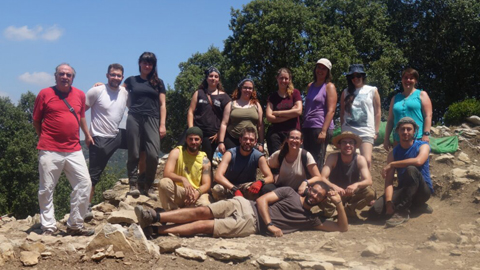A research team from the Department of Prehistory will conduct a prospecting and excavation study of the dolmen structures found in the Osona regions which will allow them to put in value the megalithic formations found in this area and in the whole of Catalonia. The project will be led by the Patronat d'Estudis Osonencs (Osona Studies Trust) thanks to the financial aid of the Creu Casas Sicart, launched by the Vives Network of Universities and the Ramon Muntaner Institute to promote research in local and regional contexts.

The research, which has received €5,000 in funding, aims to protect, document and disseminate information collected on the dolmen structures existing within the county of Osona. The project will be conducted under the coordination of lecturer Anna Bach, researcher of the Archaeological Research Group on the Mediterranean and Middle East (GRAMPO) of the Department of Prehistory, directed by lecturer Miquel Molist. The study will include the participation of university students in the prospecting and excavation tasks, and also in the treatment of materials and burial remains, while they will also be able to gain experience in the problems and studies of real cases around Europe.
The megalithic phenomenon refers to the construction of prehistoric sites with large stones, known as megaliths. These constructions took place in different periods and places around the world, but were particularly common in western Europe during the Neolithic Era (ca. 4500 to 2000 BCE). The megaliths were used for a variety of purposes, such as mass graves, places of worship, funerary monuments, solar calendars, and even as a defense mechanism. They were built using enormous stones, some of which weighed up to several tonnes, which were transported to the building sites and arranged into circles, alignments, tunnels and other complex forms.
The county of Osona and the whole of Catalonia contains funerary monuments and megalithic structures that form part of the elements of heritage of older and more recent chronology. These structures can be found practically all around Catalonia, although the state of presesrvation of each structure may vary greatly, and many times they can be found in remote areas or far away from one another, which represents problems when wanting to identify a set of dolmens, both due to erosion and to location and coordinates.
The Vives Network of Universities and the Ramon Muntaner Institute offer a yearly call for Creu Casas Sicart research grants in a local and regional grants for lecturers and researchers of universities in Catalan-speaking territories, with the collaboration of the Catalan Government's Ministry for Research and Universities through its Plan for the Reinforcement of the Use of Catalan (PEC) and the Ministry for Culture. The projects receiving funding, which can belong to any area of knowledge, must present applicability proposals and provide social return, as well as abide by the framework of the UN's Sustainable Development Goals (SDGs) both in the processes of the research and results, which must then be made publicly available.






